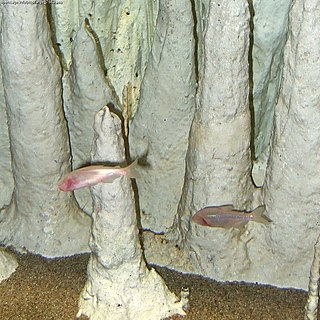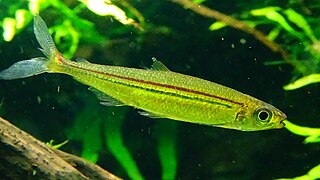
The Mexican tetra, also known as the blind cave fish, blind cave characin, and blind cave tetra, is a freshwater fish of the family Characidae of the order Characiformes. The type species of its genus, it is native to the Nearctic realm, originating in the lower Rio Grande and the Neueces and Pecos Rivers in Texas, as well as the central and eastern parts of Mexico.

The Tocantins River is a river in Brazil, the central fluvial artery of the country. In the Tupi language, its name means "toucan's beak". It runs from south to north for about 2,450 km. It is not really a branch of the Amazon River, since its waters flow into the Atlantic Ocean alongside those of the Amazon. It flows through four Brazilian states and gives its name to one of Brazil's newest states, formed in 1988 from what was until then the northern portion of Goiás.

The Amblyopsidae are a fish family commonly referred to as cavefish, blindfish, or swampfish. They are small freshwater fish found in the dark environments of caves, springs and swamps in the eastern half of the United States. Like other troglobites, most amblyopsids exhibit adaptations to these dark environments, including the lack of functional eyes and the absence of pigmentation. More than 200 species of cavefishes are known, but only six of these are in the family Amblyopsidae. One of these, Forbesichthys agassizii, spends time both underground and aboveground. A seventh species in this family, Chologaster cornuta, is not a cave-dweller but lives in aboveground swamps.

Characidae, the characids or characins, is a family of freshwater subtropical and tropical fish belonging to the order Characiformes. The name "characins" is an historical one, but scientists today tend to prefer "characids" to reflect their status as a, by and large, monophyletic group. To arrive there, this family has undergone much systematic and taxonomic change. Among those fishes remaining in the Characidae currently are the tetras, comprising the very similar genera Hemigrammus and Hyphessobrycon, as well as a few related forms, such as the cave and neon tetras. Fish of this family are important as food in several regions, and also constitute a large percentage of captive freshwater aquarium fish species.

Hyphessobrycon is a genus of freshwater fish in the family Characidae. These species are among the fishes known as tetras. The genus is distributed in the Neotropical realm from southern Mexico to Río de la Plata in Argentina. Many of these species are native to South America; about six species are from Central America and a single species, H. compressus is from southern Mexico.

Astyanax is a genus of freshwater fish in the family Characidae of the order Characiformes. Some of these fish, like many of their relatives, are kept as aquarium pets and known collectively as tetras. With around 150 described species and new ones being described yearly, this genus is among the largest of the entire order; Hyphessobrycon also has more than 145 species and which one is larger at any one time depends on whether more species have been recently described in one or the other. The blind and colorless cave tetra of Mexico is a famous member of the genus, but its taxonomic position is disputed: Some recognize it as part of the Mexican tetra and this is supported by phylogenetic evidence, but others recognize the cave form as a separate species, A. jordani.

The Paraíba do Sul, or simply termed Paraíba, is a river in southeast Brazil. It flows 1,137 km (706 mi) west to northeast from its farthest source at the source of the river Paraitinga to the sea near Campos dos Goytacazes. The river receives its name when it meets the river Paraibuna at the Paraibuna dam.

Stygofauna are any fauna that live in groundwater systems or aquifers, such as caves, fissures and vugs. Stygofauna and troglofauna are the two types of subterranean fauna. Both are associated with subterranean environments – stygofauna are associated with water, and troglofauna with caves and spaces above the water table. Stygofauna can live within freshwater aquifers and within the pore spaces of limestone, calcrete or laterite, whilst larger animals can be found in cave waters and wells. Stygofaunal animals, like troglofauna, are divided into three groups based on their life history - stygophiles, stygoxenes, and stygobites.
- Stygophiles inhabit both surface and subterranean aquatic environments, but are not necessarily restricted to either.
- Stygoxenes are like stygophiles, except they are defined as accidental or occasional presence in subterranean waters. Stygophiles and stygoxenes may live for part of their lives in caves, but don't complete their life cycle in them.
- Stygobites are obligate, or strictly subterranean, aquatic animals and complete their entire life in this environment.

Teleocichla is a genus of fish in the family Cichlidae found in the Tapajós, Xingu, Tocantins and Jari River basins, which are part of the Amazon River Basin in Brazil. All species are rheophilic, and highly elongated in shape. They generally are smaller than 9 cm (3.5 in) in length, making them some of the smallest cichlids of the Americas. Only T. preta can grow larger, reaching about 12 cm (4.7 in). Since restricted to areas with fast currents, they are particularly vulnerable to the building of dams, and the Belo Monte Dam may cause the extinction of T. centisquama. Other species recognized as threatened by Brazil's Ministry of the Environment are T. cinderella, T. prionogenys and T. wajapi.

Thayeria boehlkei is a species of characin fish endemic to the Amazon river basin and Araguaia river, in Peru and Brazil respectively. The species is popular with aquarium hobbyists where it is traded under a variety of common names including blackline penguinfish, blackline thayeria, hockey-stick tetra, penguin fish and penguin tetra.
Garra typhlops, also known as the Iran cave barb is a species of ray-finned fish in the family Cyprinidae. It is endemic to caves in Iran. Like other cave-adapted fish, it is blind and lacks pigmentation.

The blind cave eel is a species of cavefish in the family Synbranchidae. It is the longest cavefish in Australia and one of the only three vertebrates in Australia that is restricted to underground waters, the other being the blind gudgeon and the Barrow cave gudgeon. It is blind, its body is eel-like and elongated, and it has a non-pigmented skin with colours ranging from white to pink.

Pimelodella kronei is a species of three-barbeled catfish endemic to Brazil. Discovered by the German naturalist Sigismund Ernst Richard Krone, it was the first troglobitic fish described in Brazil, but several others have been described later.

Cavefish or cave fish is a generic term for fresh and brackish water fish adapted to life in caves and other underground habitats. Related terms are subterranean fish, troglomorphic fish, troglobitic fish, stygobitic fish, phreatic fish, and hypogean fish.

Bryconops is a genus of freshwater fish in the family Iguanodectidae from South America. It consists of small fish, all under half-a-foot long, with slender bodies and silvery scales, though there is some mild color variation. Several species can be identified by way of a humeral patch, and others have a reddish ocellus, or eyespot, on one or both lobes of the dorsal fin.
Mimagoniates is a genus of characid fish from rivers and streams in southeastern, southern and central-western Brazil, northeastern Argentina, and Paraguay. The individual species generally have relatively small ranges and two, M. lateralis and M. sylvicola, are considered threatened by Brazil's Ministry of the Environment.

Visual perception in animals plays an important role in the animal kingdom, most importantly for the identification of food sources and avoidance of predators. For this reason, blindness in animals is a unique topic of study.

Hasemania is a genus of characins endemic to Brazil, where only found in river basins that originate on the Brazilian Shield, ranging west to the Juruena system, north to the São Francisco system and south to the Paraná system. The individual species generally have quite small ranges and two, H. crenuchoides and H. piatan, are considered threatened by Brazil's Ministry of the Environment.

Iguanodectes geisleri, the red-line lizard tetra, is a species of freshwater fish from South America. It is a small species, largely herbivorous with some omnivorous traits, that prefers to live in schools and is partial to shallow waters, especially in blackwater habitats. Some aspects of its body plan are unique amongst its genus, including the position and length of the anal fin.
















